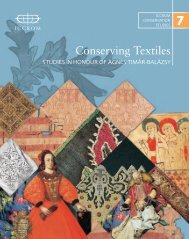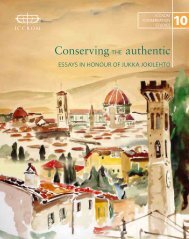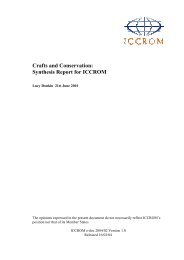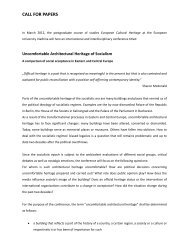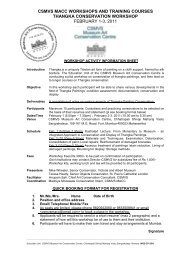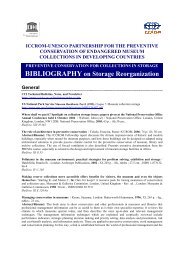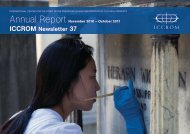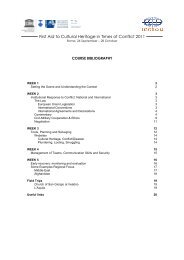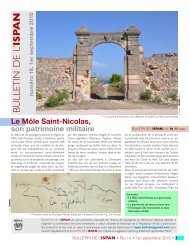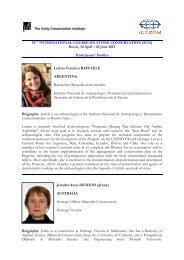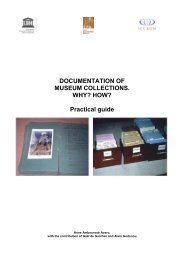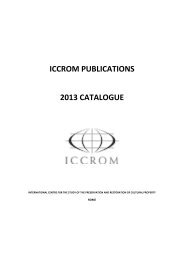part 1 - Iccrom
part 1 - Iccrom
part 1 - Iccrom
You also want an ePaper? Increase the reach of your titles
YUMPU automatically turns print PDFs into web optimized ePapers that Google loves.
MEASURING HERITAGE CONSERVATION PERFORMANCE<br />
6th International Seminar on Urban Conservation<br />
used as data to carry out this literature survey. The<br />
NF was the original document of the SP of Sri Lanka<br />
to apply for inscription on the WHL with UNESCO.<br />
However, ICOMOS being the official Advisory<br />
Body of UNESCO, the ABE is the most important<br />
document available when it comes to the justification<br />
for inscription of the historic centre of Galle on<br />
the WHL, in the absence of an official Decision Text.<br />
It was the ABE that led to inscription by UNESCO.<br />
When analysing these and other documents systematically,<br />
it is possible to conclude how far the<br />
original justification for inscription is echoed in<br />
the subsequent documents (the respective progress<br />
of each and/or the potential for conflict between<br />
arguments).<br />
The WH Committee decided to inscribe the site<br />
on the basis of cultural criterion (iv), being “an outstanding<br />
example of a type of building, architectural<br />
or technological ensemble or landscape which<br />
illustrates [a] significant stage[s] in human history”,<br />
which would mainly reflect historic values. (Pereira<br />
Roders and Van Oers, 2010).<br />
However, as can be seen in Figure 2, besides the<br />
expected historic values a multitude of other values<br />
have been identified in the Advisory Body Evaluation<br />
and Nomination File. All but the age value are<br />
represented in expressing the OUV of the property<br />
as stated by ICOMOS and the SP, so inscription<br />
solely on the historic value of criterion (iv) seems to<br />
do the historic centre of Galle injustice. One reason<br />
for this discrepancy could be the general character<br />
of the historic aspect of criterion (iv). As the nomination<br />
concerns the historic centre of Galle dating to<br />
the period from the 16 th to 19 th century, this would<br />
make all its attributes of historic value, regardless of<br />
their aesthetic or economic nature. This could have<br />
left other cultural values unjustly undervalued in<br />
the process. In applying this insight, we can see<br />
that other cultural values become more prominent<br />
in both documents at the expense of the historic<br />
value; for example, the aesthetic and political value<br />
in <strong>part</strong>icular now seem to be highly represented in<br />
the documents.<br />
Now, when comparing the cultural values of the<br />
ABE with those of the Nomination File (NF), we can<br />
see how far the original justification for inscription<br />
is echoed along the subsequent documents and if<br />
similarities or discrepancies exist between them.<br />
The following preliminary conclusions can be made<br />
about the individual cultural values identified in<br />
these documents:<br />
Similarities: Some small differences aside, both<br />
documents highly represent political and aesthetical<br />
values.<br />
Discrepancies: The NF seems to give considerably<br />
more importance to the social and economic<br />
values than the ABE does, whereas it<br />
considers the historic, scientific and ecological<br />
values of far less importance than does the<br />
ABE.<br />
5.1. Attributes<br />
Besides the ascription of cultural values in order<br />
to make different official documents comparable, by<br />
analysing the ABE and NF systematically it is also<br />
possible to identify implicit and explicit descriptions<br />
of the attributes that convey the Outstanding<br />
Universal Value in the historic centre of Galle.<br />
For instance, the ABE states: “Galle provides an<br />
outstanding example of an urban ensemble which<br />
illustrates the interaction of ‘European architecture’<br />
and ‘South Asian traditions’ from the 16 th to the 19 th<br />
centuries”.<br />
Those are rather vague and general descriptions,<br />
so further elaboration on the terms ‘European architecture’<br />
and ‘South Asian traditions’ is needed to<br />
find the features applicable to the attributes in Galle<br />
Fort, which express the interaction of the two terms<br />
stated above. Further in the ABE, more specific<br />
description is given of the interaction of the South<br />
Figure 2. Cultural values identified in the Advisory Body Evaluation and the Nomination File (Boxem and Fuhren,<br />
November 2010).<br />
Boxem, R.; Fuhren, R.; Pereira Roders, A.; Veldpaus, L.·& B. Colenbrander. 2012. Assessing the cultural significance of World Heritage<br />
cities: the historic centre of Galle as a case study. In Zancheti, S. M. & K. Similä, eds. Measuring heritage conservation performance, pp.<br />
75-81. Rome, ICCROM.<br />
79



